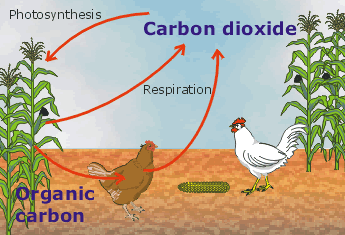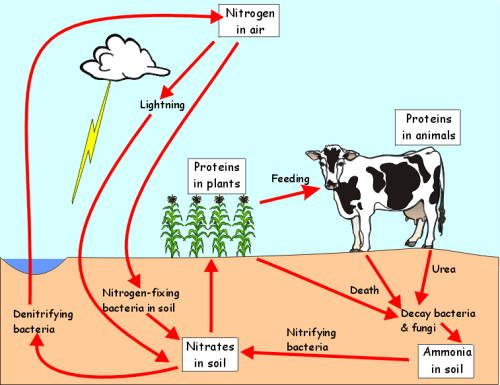Nutrient Cycles
Carbon, oxygen, nitrogen and water circulate in the environment. Even though they continuously change from one form to another, these materials stay in roughly the same proportions within ecosystems (interaction between living things and their surroundings). Energy does not cycle, instead it flows through ecosystems in a straight line. At the end all the energy is lost. All living things eventually die. So, what happens to their bodies? Death and decay play an important part in the ecosystem. The remains of plants and animals decay quickly. Living organisms are decomposed (broken down) by microbes. These microbes obtain energy and materials to grow and reproduce. Examples of decomposers include worms and slugs. Why are decomposers important? Decomposers are important in food webs because they:
- Eat biomass that other things cannot use.
- Return materials, which plants need, back to the soil.
Microbes therefore allow the elements of life to be used again and again. This is called recycling. In every ecosystem there are consumers that feed only on the dead remains of others. These animals prevent the environment from getting cluttered up with dead bodies and waste. They also help to recycle materials.
Animals that Consume Dead Remains
- Scavengers - feed on dead animals or plant remains (e.g. snails in a pond eat dead fish, crows feed on dead insects, birds and rabbits, and seagulls eat scraps of our discarded food. Note that these animals are not scavengers all the time - they can fill other 'slots or links' in foodchains).
- Decomposers - do not eat dead animals or plants. They digest them (physically and chemically change the food) by releasing enzymes on to the remains to break them down into smaller and simpler substances. Some of the simpler substances are then absorbed into the decomposer's own cells. Examples of decomposers include bacteria and fungi. These organisms are important in the cycling of materials in the soil environment. Producers then take up these materials which decomposers have made. They use them to grow and so make them available for living animals in food chains.
There are only limited resources on this Earth and when certain chemicals or nutrients are used by organisms, they must be replaced somehow otherwise they will run out. Many of the important elements are changed from one chemical to another and back again in cycles. Two important elements are Carbon and Nitrogen . Carbon is important as it is found in almost every chemical in every living organism, from cellulose cell walls to fat droplets to haemoglobin in red blood cells. Nitrogen is used to make proteins which have a wide variety of uses, many essential to life. The way in which these two elements are recycled is very important.
Carbon Cycle
Carbon exists mainly as organic compounds in organisms and inorganic carbon dioxide. Carbon dioxide in the air is used by plants in photosynthesis in order to make organic compounds for food. These can be used by the plant in respiration or eaten by animals. Animals also respire and the carbon is returned to the atmosphere as carbon dioxide. When animals and plants die, they decay. Microbes such as bacteria and fungi turn the organic materials into its basic constituents. Carbon is converted into carbon dioxide when the microbes respire. Some organisms did not decay when they died. These organisms died in circumstances which prevent microbes from working, in a marsh or at the bottom of a muddy river bed. After years of sediment build up the layers turn into rock and the dead organisms turn into fossil fuels. When these are burnt in combustion, carbon dioxide is made once more.

The amount of carbon dioxide in the atmosphere has been increasing due to the increased use of fossil fuels and deforestation resulting in the clearing of woodland. This increase in the levels of carbon dioxide has been the main factor in Global Warming.
Nitrogen Cycle
Nitrogen can be found in many forms in the environment.
- Nitrogen gas is found in the air. It makes up around 79% of the atmosphere.
- Ammonia from the result of decaying matter, usually dissolved in water.
- Nitrates in the soil, again usually dissolved in water.

Decomposers, such as bacteria and fungi feed on the protein in dead organisms and urea excreted by animals. This produces ammonia, dissolved in water in the soil. Nitrifying bacteria in the soil convert the ammonia to nitrites and then to nitrates dissolved in the water. Plants absorb nitrates through their roots. They use the nitrates to make protein. Animals cannot do this so they must consume plants (or animals which eat plants) in order to aquire protein for themselves.
Nitrates can get into the soil in other ways. Nitrogen-fixing bacteria exist in the soil which can turn atmospheric nitrogen into nitrates in the soil. Some nitrogen-fixing bacteria can be found in root nodules of certain plants (pea, bean and clover plants for example). Nitrates can also enter the soil in lightning storms. Lightning causes oxygen and nitrogen to react with each other and the oxides of nitrogen dissolve in the falling rain water. Nitrates can be put into the soil artificially by Man when chemical fertilisers are used. These are made by using atmospheric nitrogen to make ammonia and nitric acid.
De-nitrifying bacteria can be found in places like swamps and marshes. These bacteria turn nitrates back into atmospheric nitrogen.
